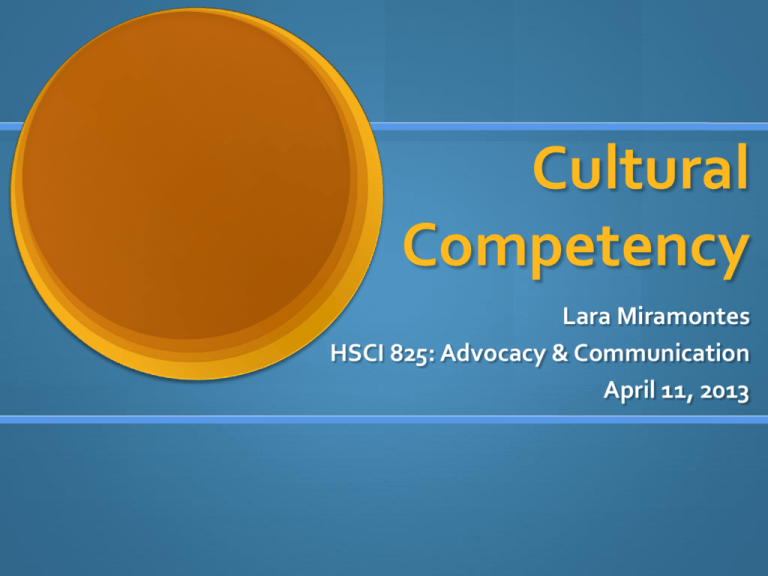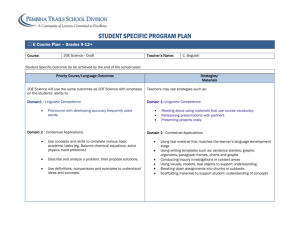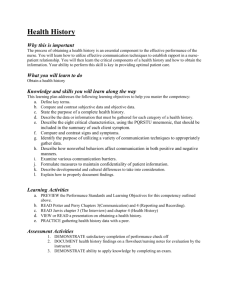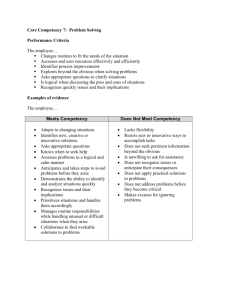CultComp_Miramontes_825
advertisement

Cultural Competency Lara Miramontes HSCI 825: Advocacy & Communication April 11, 2013 Overview • History and Terminology • What is Culture? • Cultural Competency 101 • Relevance to Public Health • Questions? History and Terminology • Cultural competency Intercultural / cross-cultural competency Cultural sensitivity Cultural humility (USA: Tervalon, Murray-García) Cultural safety (New Zealand, Canada) Intercultural / cross-cultural communication • Basis in patient-centered medicine (1970s-1980s) • Developed from immigrants to all cultural groups; encompasses privilege, prejudice, social determinants; interpersonal, community and systemic implications • Now embedded in many disciplines and embraced by business, nonprofit, government, healthcare sectors What Defines Your Culture? What Defines Your Culture? What Defines Your Culture? What is Culture? • “Culture is the learned and shared knowledge that specific groups use to generate their behavior and interpret their experience of the world.” • “Most cultural groups tend to believe that how they see the world is correct, and how they believe and behave is what is most natural to human beings; that is, ‘human nature.’ However, in learning about culture, we need to understand that to have culture is human nature, but no specific culture is human nature!” (National Center for Cultural Competence. [N.D.]) What is Culture? Cultural Competency 101 • “Having the knowledge that cultural differences as well as similarities exist, without assigning values such as better, worse, right or wrong to those… differences.” (Devore & Schlesinger, 1996) • A mindset that leads to lifelong learning with: Respect for differences Eagerness to learn Willingness to accept that there are many different ways of viewing the world • It is not knowing everything about every culture! Cultural Competency 101 • Awareness of culturally imbued biases, beliefs • Knowledge of culturally relevant language, facts • Skills for culturally appropriate interventions (Sue et al., 1982) • Attitude that moves beyond the intellectual to compel continuous reexamination, assessment (Martin & Vaughn, 2007) Relevance to Public Health • Diversity and equity stressed by CPHA, CIHR; culture embedded in core public health competencies • Qualitative reflexivity sought even in quantitative studies • Cultural competency is an emerging, expansive field! Growing relevance and lots of opportunity • Within 20 years, 80% of Canada’s population growth owed to new immigrants (Martel & Chagnon, 2013) Relevance to Public Health What can public health practitioners do? • Basic understanding of cultural background is helpful, but not the only necessary step Good intentions, but can lead to stereotyping Can bypass importance of understanding the individual • Acknowledge cultural differences; understand your own (personal, institutional) culture (including biases and racism); engage in self-assessment; acquire cultural knowledge & skills; view behavior within cultural context Questions? References Blough, M., Burgoyne, K., and Tran, T. Cultural Competency Training: Bridging the Cultural Divide. Developed by and accessed with permission via Americana Community Center, Louisville KY. For more information: www.americanacc.org. Contact: (502) 366-7813, maria@americanacc.org or kristin@americanacc.org. Canadian Public Health Association. (N.D.). Cultural Competency. Accessed via http://www.cpha.ca/en/activities/safeschools/culture.aspx on April 8, 2013. Center for Victims of Torture. (N.D.). Healing the Heart (informational pamphlet). For more information: http://www.cvt.org/. Devore, W., and E. G. Schlesinger. 1996. Ethnic-sensitive social work practice (4th edition). Boston: Allyn & Bacon. References Cont’d Martel, L. and Chagnon, J. (2013 January 8). Population growth in Canada: From 1851 to 2061. Prepared for Statistics Canada. Accessed via http://www12.statcan.gc.ca/census-recensement/2011/as-sa/98310-x/98-310-x2011003_1-eng.cfm on February 14, 2013. Martin, M., & Vaughn, B.E. (2007). Cultural competence: The nuts & bolts of diversity & inclusion. Strategic Diversity & Inclusion Management: pp. 31-38. San Francisco: Diversity Training University International Publications Division. National Association of Social Workers. (2001). NASW Standards for Cultural Competence in Social Work Practice. Accessed via http://www.naswdc.org/practice/standards/NAswculturalstandards.p df on April 8, 2013. National Center for Cultural Competence. (N.D.). Accessed via http://nccc.georgetown.edu/ on April 8, 2013. References Cont’d Saha, S., Beach, M.C., and Cooper, L.A. (2008 November). Patient Centeredness, Cultural Competence and Healthcare Quality. Journal of National Medical Association, 100(11): pp. 1275–1285. Simon Fraser University. (N.D.). Core Public Health Competencies. Accessed via http://www.fhs.sfu.ca/docs/Core%20Public%20Health%20Comp etencies.pdf on April 8, 2013. Sue, D. W., Bernier, J. E., Durran, A., Feinberg, L., Pedersen, P., Smith, C. J., et al. (1982). Cross-cultural counseling competencies. The Counseling Psychologist, 19(2): pp. 45–52. References Cont’d Tervalon, M., and Murray-García, J. (1998 May). Cultural humility versus cultural competence: A critical distinction in defining physician training outcomes in multicultural education. Journal of Health Care for the Poor and Underserved, 9(2): pp. 117-125. Williams, R. (1999). Cultural safety — what does it mean for our work practice? Australian and New Zealand Journal of Public Health, 23: pp. 213–214. Image Sources • Slide 5-6: http://melbaylon.wordpress.com/2012/01/10/musingson-nationality/; http://treecitytimes.blogspot.ca/2012/07/absurdity-ofpolitically-correct-gender.html; http://www.counselor.org/gender.html; http://humanitiesresearch.ca/research-clusters/disabilityresearch-cluster/; http://www.gegca.com/en/index.php?option=com_content&vie w=article&id=143:professional-team&catid=43; http://www.edrawsoft.com/clipart-religion.php; http://www.clker.com/clipart-9736.html • Slide 12: Credit: Dana Duncan, accessible through https://www.facebook.com/AmericanaCommunityCenter








